Other Publications
The following publications, covering various aspects of the work of the International Law Commission have been prepared and published by the Secretariat of the United Nations. (see also Yearbook of the International Law Commission)
Work of the International Law Commission, 10th ed. (2023)

The Work of the International Law Commission, 10th ed., vol.1
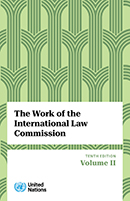
The Work of the International Law Commission, 10th ed., vol.2,
[Purchase]
The United Nations Programme of Assistance in the Teaching, Study, Dissemination and Wider Appreciation of International Law, established under General Assembly resolution 2099 (XX) of 20 December 1965, includes among its goals the dissemination of information about international law and activities in this field. In connection with this goal, the first edition of the present publication was prepared by the Secretariat in 1966. The second, third, fourth, fifth, sixth, seventh, eighth and ninth editions were produced in 1972, 1980, 1988, 1996, 2004, 2007, 2012 and 2017 respectively, further to requests of the International Law Commission which were endorsed by the General Assembly. The present, tenth edition, brings up to date the previous edition by incorporating therein a summary of the latest developments of the work of the Commission, as well as texts of new Commission drafts. This edition reflects developments as of 31 December 2022.
Under Article 13, paragraph 1, of the Charter of the United Nations, the General Assembly is required to “initiate studies and make recommendations for the purpose of ... encouraging the progressive development of international law and its codification”. As a means for the discharge of these responsibilities, the General Assembly, in 1947, established the International Law Commission.
The present publication is intended to provide a general introduction to the work of the International Law Commission, with sufficient references to facilitate further research. Accordingly, the publication contains, in Part I, a brief historical outline of the various attempts at the development and codification of international law up to the inception of the Commission’s work and, in Part II, an account of the organization, programme and methods of work of the Commission, with particular reference to the Statute under which the Commission functions. Finally, Part III is devoted to brief descriptions of the various topics and sub-topics of international law considered by the International Law Commission. An account is also given of the actions decided upon by the General Assembly following the consideration of the topics or subtopics by the Commission, and of the results achieved by diplomatic conferences convened by the General Assembly to consider drafts prepared by the Commission or by the General Assembly itself.
Annexes are appended, containing the text of the Commission’s Statute, a list of present and former members of the Commission, the text of the decision of the Swiss Federal Council regarding the juridical status of the members of the Commission at the place of its permanent seat at the United Nations Office at Geneva, an indication of the periods in which topics were considered by the Commission, and, where appropriate, the texts of multilateral conventions adopted by diplomatic conferences convened under the auspices of the United Nations or the General Assembly itself, or the texts, including draft articles, finalized by the Commission. The multilateral conventions contained in annex V, as well as the texts finalized by the International Law Commission, contained in annex VI, appear in volume II.
Seventy Years of the International Law Commission: photo exhibit (2020)
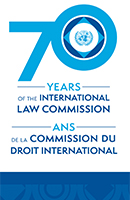
Seventy Years of the International Law Commission (photo exhibit)
As the preamble of the Charter of the United Nations proclaims, international law — the rules that govern the relations between States and, increasingly, with international organizations and individuals — is central to a just and peaceful world. International legal rules enable international trade, protect our environment, facilitate diplomatic relations and safeguard human rights. Moreover, they allow States to resolve their disputes peacefully, by relying on law instead of force.
In national legal systems, laws are typically made by a central lawmaker, such as a parliament or congress. At the global level, there is no single body that can legislate for the world. Instead, international law mainly emanates from customary practices and agreements between States. For centuries, most of international law remained in unwritten form. This was still the case when the United Nations was founded in 1945.
To help clarify, order and formulate — to codify and progressively develop — the most fundamental rules of international law, the United Nations established the International Law Commission in 1947. In the past seven decades, the International Law Commission has played an indispensable role in the progressive development of international law and its codification.
This publication examines past and present efforts to progressively develop and codify international law. It has been prepared by the Codification Division of the United Nations Office of Legal Affairs to mark the seventieth anniversary of the first session of the International Law Commission in 1949. Its contents are based on a photo exhibit that has been on display in New York, Geneva, The Hague, Bangkok and Washington, D.C., among other places, in 2018 and 2019.
Seventy Years of the International Law Commission: Drawing a Balance for the Future (2020)

Seventy Years of the International Law Commission
The International Law Commission convened its seventieth session in New York from 30 April to 1 June and in Geneva from 2 July to 10 August 2018 under the overarching theme: “Seventy Years of the International Law Commission — Drawing a Balance for the Future”. To commemorate the anniversary session, events were organized in New York on 21 May 2018 and in Geneva on 5 and 6 July 2018. At each venue, a solemn celebratory segment was followed by substantive panel discussions: a “conversation” with delegates to the Sixth (Legal) Committee of the General Assembly in New York; and a symposium with legal advisers of foreign ministries and other international law experts in Geneva.
Seventy Years of the International Law Commission: Drawing a Balance for the Future brings together voices from academia and practice to celebrate and critically evaluate the work of the United Nations International Law Commission (ILC) over the past seventy years. The edited volume draws on the events commemorating the seventieth anniversary of the Commission, which took place in New York and Geneva in May and July 2018. At a time when multilateral law-making has become increasingly challenging, the edited volume appraises the role of one the most important driving forces behind the codification of international law and discusses the ILC’s future contribution to the development of international law.
Analytical Guide to the Work of the International Law Commission, 1949–1997 (1998)
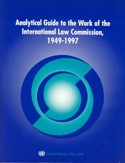
Analytical Guide to the Work of the International Law Commission, 1949–1997 (1998)
The Codification Division of the Office of Legal Affairs, in its capacity as Secretariat of the International Law Commission, prepared a comprehensive and annotated Analytical Guide to the Work of the International Law Commission, covering the period of work 1949 to 1997, in commemoration of the fiftieth anniversary of the International Law Commission in 1998, and to complement the publication, The Work of the International Law Commission, now in its eighth edition. The Guide is intended to serve as a research tool for researchers and academics to evaluate the Commission's contribution to the codification and progressive development of international law during its first fifty years of existence.
The Guide is organized by topics, subdivided into categories and stages of consideration within the Commission; thus allowing the reader to trace the development of each and every topic from inception to conclusion. A brief description of the Commission's treatment is provided, together with references to source material including the Yearbook of the International Law Commission, the Report of the International Law Commission, and the reports of the Special Rapporteurs.
An online version of the Analytical Guide to the Work of the International Law Commission is available on this web site
International Law Commission on the Eve of the Twenty-first Century (1997)
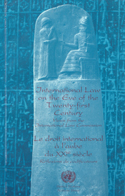
International Law Commission on the Eve of the Twenty-first Century (1997) |
[Purchase]
"The purpose of this book is not to take stock of the Commission's work, although the Introduction, drafted by the Codification Division of the United Nations Secretariat, provides a valuable outline for such an endeavour by attempting to evaluate the interaction between the Commission's work and general international law, stressing the influence of the former on the evolution of the latter. It is, more modestly, to offer to the public a collection of essays, drafted by 20 members of the Commission, on very varied topics, linked above all by their essentially forward-looking nature.
The Commission felt that in publishing this collection of essays, which reflects the views of its members on topics which they consider to be of particular importance, it would be playing its part in the United Nations Decade of International Law, proclaimed by the General Assembly in resolution 44/23 of 17 November 1989. It hopes that it will be contributing in this manner to the teaching, study, dissemination and wider appreciation of international law."
Alain Pellet
Making Better International Law: the International Law Commission at 50 (1998)
During the last 50 years, the International Law Commission has been at the forefront in meeting the challenges facing the world community in the realm of international law. The papers presented in this publication, from a mixed group of policy-makers, practitioners, international law-makers and academics, explore ways of strengthening the International Law Commission. Practical proposals that might enable the Commission to contribute still more effectively to the progressive development of international law and its codification are presented along with a range of papers and documents relating to the Commission, its work and its achievements.
The International Law Commission, Fifty Years After: an Evaluation (2000)
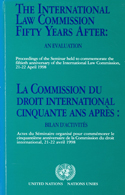
The International Law Commission, Fifty Years After: an Evaluation (2000) |
[Purchase]
In April 1998, fifty years after its first members were elected, the Commission organized a seminar in Geneva, focused mainly on an evaluation of its work up to that date. This publication contains the proceedings of that seminar.
This two-day Seminar was held pursuant to General Assembly resolution 52/156, which welcomed the decision of the International Law Commission to hold the Seminar to celebrate the fiftieth anniversary of the Commission. It took place on 21 and 22 April 1998, during the fiftieth session of the Commission, at the United Nations Office in Geneva.
Participants included academics and current and former members of the International Law Commission. In order to facilitate a full and frank exchange of views, it was understood that all who took part did so in their personal capacity, and not on behalf of any State, organization or institution.
The Seminar took the form of successive discussions of six topics pertaining to the core theme of an evaluation of the Commission after fifty years of work. At the Seminar, the panellists made a presentation on their individual topics, which was followed by comments from other designated panellists. The floor was then opened up for discussion. These presentations and comments, as well as the open-floor discussions, are included in this publication under their topics in the order in which they occurred.
The publication also contains two annexes, in order to provide the reader with information on the International Law Commission. The first annex contains the present membership of the International Law Commission, and the second annex contains the Statute of the Commission.
